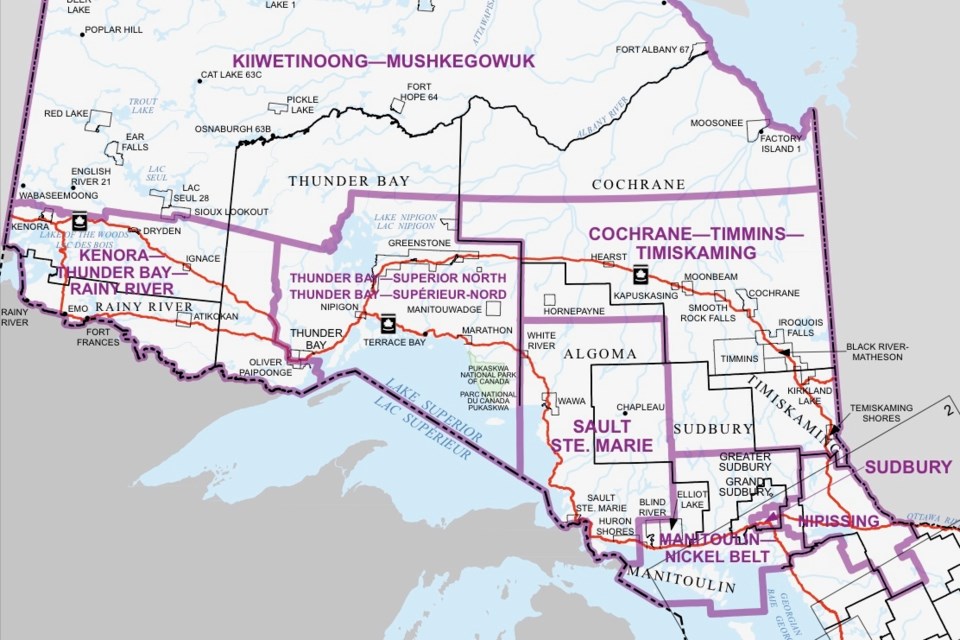Proposed changes to the federal riding boundaries could allow for larger Northern Ontario ridings and reduce the number of Members of Parliament elected in the north.
The Federal Electoral Boundaries Commission for Ontario released the proposed new electoral map on Friday, Aug. 19. If approved, it would see remapping Northern Ontario riding boundaries to increase the area MPs cover and have one fewer MP in the north. For Timmins, the James Bay coastal communities would be removed from the riding and the new boundary would extend south to the Cobalt area.
"The proposed changes to the electoral boundaries of Northern Ontario represents a major diminishment of the north’s ability to have adequate representation on the national stage. It is a kick in the teeth to the fundamental principle that people in the isolated north have a right to be able to interact with and receive service from their MP offices," wrote Timmins-James Bay MP Charlie Angus in a Facebook post.
"The fact that the Boundary Commission has released this report as northern municipalities are heading into municipal elections is a further slap in the face. This means that municipal officials and councils will be excluded from the public comment period. Talk about stacking the deck."
In the news release announcing the changes on Friday, the Federal Electoral Boundaries Commission for Ontario said the proposed changes were developed by an independent and non-partisan process.
"In exercising its mandate under the Electoral Boundaries Readjustment Act and given the allocation of one additional district to Ontario, the Commission found it necessary to propose many new electoral boundaries to correct wide variations in voter equality that have emerged across the province over the past decade due to population change," said the Honourable Justice Lynne C. Leitch, chair of the three-member commission.
The proposal locally is to create the riding of Cochrane-Timmins-Timiskaming. It would cover from Hearst and Hornepayne in the northwest and extend south to Cobalt.
The municipalities included in the proposed new riding are Timmins, Temiskaming Shores, Cobalt, Cochrane, Englehart, Hearst, Iroquois Falls, Kapuskasing, Kirkland Lake, Latchford, Smooth Rock Falls and Charlton and Dack. The townships in those areas are also included. The First Nations communities included are Abitibi, Constance Lake, Flying Post, Matatchewan, Mattagami and New Post.
"Having regular MP service across this region will not be possible. It will also mean that small communities have to compete with more communities for funding in all manner of programs. As the federal government withdraws services to the public the MP’s office has become a major point of contact for passports, pensions, immigration cases," said Angus in his post.
The population of a Cochrane-Timmins-Timiskaming riding is 107,097, compared to 80,785 people in the existing Timmins-James Bay.
The James Bay area would be part of a new riding called Kiiwetinoong-Mushkegowuk, which would extend from Moosonee and Moose Factory in the east right to the Manitoba border to be 520,307 square kilometres. The total population is pegged at 36,427.
With the rise of immigration, Angus said there's a need to make sure services are not being cut.
"It must be stated that Canadian democracy is not based on representation by population but on the need to ensure adequate representation for regions and distinct identities. The courts have been very clear on this. This is why the system allows a large variety of population figures for ridings running from 26,000 in Labrador to 68,000 in some rural Saskatchewan ridings," he said.
"And yet Northern Ontario’s ridings are being pegged to the average in densely populated South Ontario. Northern Ontario is a vast region of often isolated communities whose political, economic and social realities are completely distinct from southern Ontario. I have been speaking with leaders from across the north who recognize this attack on northern representation must be challenged. We already face major challenges for building on the vitality of this vast region of the north. We cannot have the federal boundary commission denying us democratic representation."
In-person and virtual meetings are being held for the public to comment.
In Timmins, the in-person event is on Tuesday, Oct. 11 at the Senator Hotel at 6:30 p.m. The virtual hearing for Northern Ontario is on Wednesday, Oct. 26 at 6:30 p.m.
The full map of the redrawn boundaries is available here.



